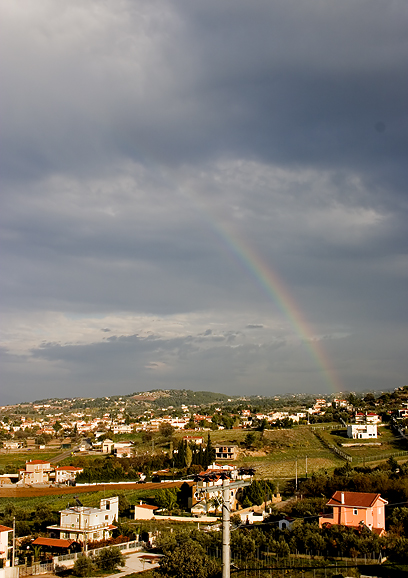
One of the most impressive light shows that one can experience from the surface of the earth is that involving the
ionization of particles in the atmosphere and which leads to the "dancing lights" commonly referred to as Aurora Borealis
and Aurora Australis (see here). Perhaps an equally impressive light show and probably
more frequent, certainly in the Meditteranean, is the rainbow which graces the sky with a dramatic refraction pattern
of the white light spectrum.
More specifically, when solar sunlight encounters water droplets, it is partitioned into its constituent spectral colors
and dispersed back to the ground observer. This phenomenon, commonly studied in optics and described as early as 1637
by Rene Descartes, has several interesting features including a set of circular colored arcs in the form of parallel bows
with a common center; the sun is immediately behind the observer facing the rainbow; and the center of the arcs are
precisely 180° away from the associated light source (the sun). Furthermore, the angle between the incident ray of light
entering the water drop(s) and that redirected back to the observer (resultant ray) varies between 40° and 42° and, hence,
accounts for the observed spectral pattern (blue has the least refraction angle at 40° whereas red the greatest at an
angle of 42° with the balance of the colors lying between these two extrema).
Finally, the location of the sun during this refraction process determines the size of the rainbow arcs. When the sun is
low to the horizon (ex. around sunset), the rainbow arcs are very large and can approach the size of a semi-circle. In
contrast, when the sun is very high, these arcs are much smaller. On very rare occasions, the incident ray of sunlight
will be reflected a second time within the rain drop and thus lead to a resultant exit ray which is not between 40° and
42° but one between 52° and 53° and, thus, yield a further and secondary rainbow which coincidentally has its color
sequence in reverse to that of the primary rainbow.
Note: A very light mist of fine rain helped make this rainbow visible about two hours before
the sun was about to set in the southwest.
|
Body: Sun Mass: 332,900 x Earth Mean Eq Diameter: 109.1 x Earth Distance: 152 million km RA / Dec: 05h 04m 37s / 22° 49' 43" Diameter: 32.37' Magnitude: -26.8 Light Time: 0h 8m 21.6s |

|
Date: Nov 30, 2007 15:28:32 UT+2 Location: Athens, Greece Equipment: Canon EOS 300d Canon EOS EF-S 18-55 mm @ 30 mm Exposures: 1 x 1/200 sec @ f10.0 ISO 100 RAW Image Format 3072x2048 Image Size Manual Mode Software: Canon FileViewer V1.3.2 Photoshop CS2 Processing: RAW to TIFF (16-bit) Conv Resampling JPG Compression |